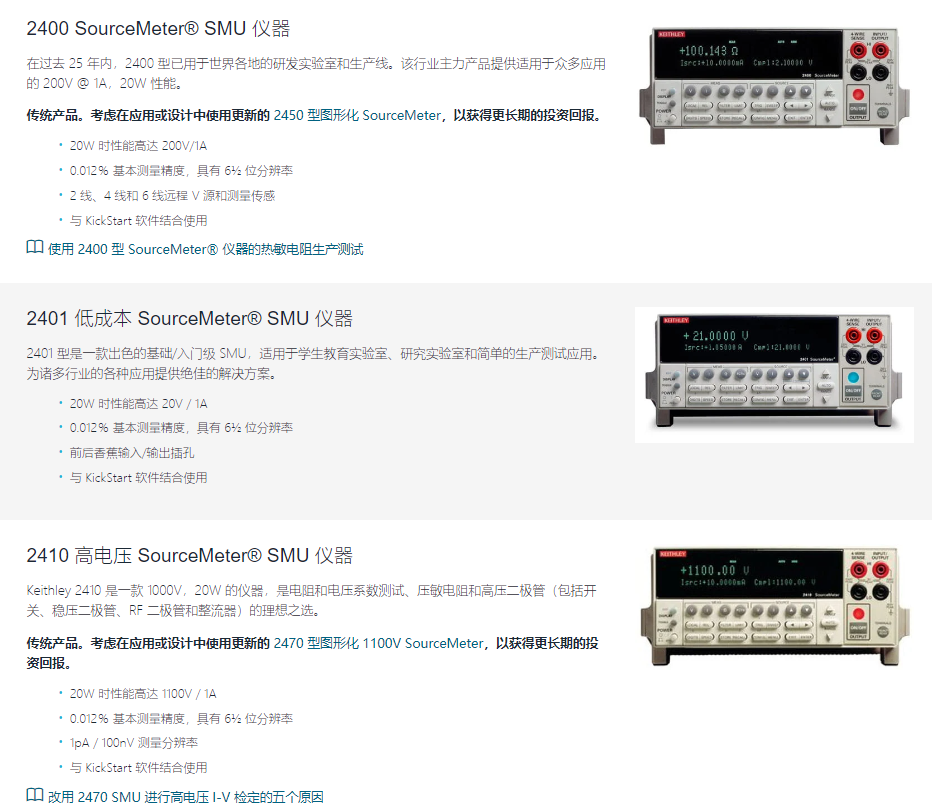Keithley 2400 Series (2410,2420,2430) - FAQs
Keithley's line of digital source meters are particularly well suited for test applications that require precision voltage source and current source drivers for simultaneous current and voltage measurements. All source meters provide precision voltage and current source measurement capability. Each source meter consists of a highly stable DC source and a true instrument-grade 5½-digit multifunction meter. The source features include: low noise, high accuracy and readback capability. Multimeter features include high repeatability and low noise. The result is a compact single channel DC parameter tester.
Performance up to 200V/1A at 20W
0.012% basic measurement accuracy with 6½ bit resolution
2-, 4- and 6-wire remote V-source and measurement sensing
Used in conjunction with KickStart software
How to set the output power value?
First select the type of power output, voltage output or current output, then press "EDIT", the cursor will stop at the lower left "Power Output Value" (Isrc or Vsrc), you can change the cursor position by pressing the left or right button of EDIT, and you can set the value by pressing each button directly (e.g., "LOCAL" means "0", "REL" means "1"...), or press ▲ and ▼ to change the value. You can change the cursor position by pressing EDIT left or right, and set the value by pressing each key directly (e.g., "LOCAL" means "0", "REL" means "1", etc.), or press ▲ and ▼ to change the value.
What is the clamping value (compliance)? How to set the clamping value?
In order to protect the instrument and the components to be measured from damage caused by short-circuit in the output circuit, it is necessary to set a clamping level, if the measured value is greater than the clamping level, it will be automatically limited to the clamping level to protect the components and the instrument (if the measured value is greater than the clamping level, the "Cmpl" at the bottom right of the screen will blink, and it will be limited to the set clamping value). Therefore, if it is output voltage, we must set the clamping value of measured current; on the other hand, if it is output current, we must set the clamping value of measured voltage.
The setting method is as follows:
First select the type of power supply to be output, voltage output or current output.
Then press "EDIT" twice, the cursor will stop at "Cmpl" in the lower right.
The cursor will stop at the lower right "Clamping value" (Cmpl), you can change the cursor position by pressing the left or right button of EDIT, and you can set the value by pressing each button directly (e.g. "LOCAL" means "0", "REL" means "1"...), or press ▲ and ▼ to change the value.

Keithley's line of digital source meters are particularly well suited for test applications that require precision voltage source and current source drivers for simultaneous current and voltage measurements. All source meters provide precision voltage and current source measurement capability. Each source meter consists of a highly stable DC source and a true instrument-grade 5½-digit multifunction meter. The source features include: low noise, high accuracy and readback capability. Multimeter features include high repeatability and low noise. The result is a compact single channel DC parameter tester.
Performance up to 200V/1A at 20W
0.012% basic measurement accuracy with 6½ bit resolution
2-, 4- and 6-wire remote V-source and measurement sensing
Used in conjunction with KickStart software
How to set the output power value?
First select the type of power output, voltage output or current output, then press "EDIT", the cursor will stop at the lower left "Power Output Value" (Isrc or Vsrc), you can change the cursor position by pressing the left or right button of EDIT, and you can set the value by pressing each button directly (e.g., "LOCAL" means "0", "REL" means "1"...), or press ▲ and ▼ to change the value. You can change the cursor position by pressing EDIT left or right, and set the value by pressing each key directly (e.g., "LOCAL" means "0", "REL" means "1", etc.), or press ▲ and ▼ to change the value.
What is the clamping value (compliance)? How to set the clamping value?
In order to protect the instrument and the components to be measured from damage caused by short-circuit in the output circuit, it is necessary to set a clamping level, if the measured value is greater than the clamping level, it will be automatically limited to the clamping level to protect the components and the instrument (if the measured value is greater than the clamping level, the "Cmpl" at the bottom right of the screen will blink, and it will be limited to the set clamping value). Therefore, if it is output voltage, we must set the clamping value of measured current; on the other hand, if it is output current, we must set the clamping value of measured voltage.
The setting method is as follows:
First select the type of power supply to be output, voltage output or current output.
Then press "EDIT" twice, the cursor will stop at "Cmpl" in the lower right.
The cursor will stop at the lower right "Clamping value" (Cmpl), you can change the cursor position by pressing the left or right button of EDIT, and you can set the value by pressing each button directly (e.g. "LOCAL" means "0", "REL" means "1"...), or press ▲ and ▼ to change the value.








